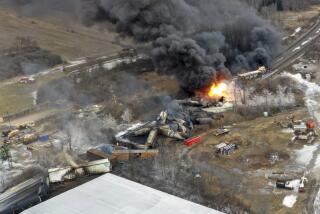A Ringing Nuclear Alarm
- Share via
Imagine a mansion filled with a priceless art collection. Burglars are casing the neighborhood, but the homeowner downplays warnings from neighbors and the police. Instead of installing a top-notch security system, the owner decides to cheap it out, adding a few deadbolt locks. A few weeks later, criminals loot the art and trash the house.
This is the kind of overconfidence that the Energy Department displays with its inadequate nuclear security measures at numerous nuclear laboratories. A new General Accounting Office study and a hearing held by Rep. Christopher Shays (R-Conn.) last week indicate that despite years of warnings, the department continues to underestimate the threat of a terrorist attack in order to hold down security costs.
The government has nuclear materials stored in at least seven weapons sites. The most vulnerable is probably Lawrence Livermore National Laboratory, a defense research lab managed by the University of California and surrounded by homes in Alameda County.
Energy Department analysts estimated in 2002 that if well-trained terrorists penetrated Livermore’s Superblock building, which contains weapons-grade material, they could rapidly assemble and set off a nuclear device, leveling the surrounding city and killing tens of thousands.
Since then, the Energy Department has taken some minimal steps, including more frequent checks of vehicles. But the GAO says that although these measures may increase visible security, they may undermine it in reality. Guards are overworked, undertrained and quick to quit. What’s more, the department uses inadequate measures to secure nuclear materials, claiming they’re less significant than nuclear weapons. Any community hit by a “dirty bomb” is unlikely to make such a distinction.
Perhaps most startling is the department’s resistance to accepting intelligence analyses that a much larger terrorist force might attack than it estimates.
True to its blinkered nature, the department held a hearing Tuesday outlining its proposal to double the amount of plutonium held at Livermore. Instead of pursuing the proposal, Energy Secretary Spencer Abraham should consolidate plutonium stocks, which are spread out at different laboratories. The sensible safety move would be to shift Livermore’s nuclear materials to the far more secure Nevada Test Site, where the government used to conduct underground nuclear testing. In addition, Abraham should take the painfully obvious steps of drawing up long-range cost estimates as well as a plan for new security measures.
Perfect security will never exist, but with government investigators pointing out such glaring shortcomings, the fixes are dangerously overdue.
More to Read
Get the L.A. Times Politics newsletter
Deeply reported insights into legislation, politics and policy from Sacramento, Washington and beyond. In your inbox twice per week.
You may occasionally receive promotional content from the Los Angeles Times.










